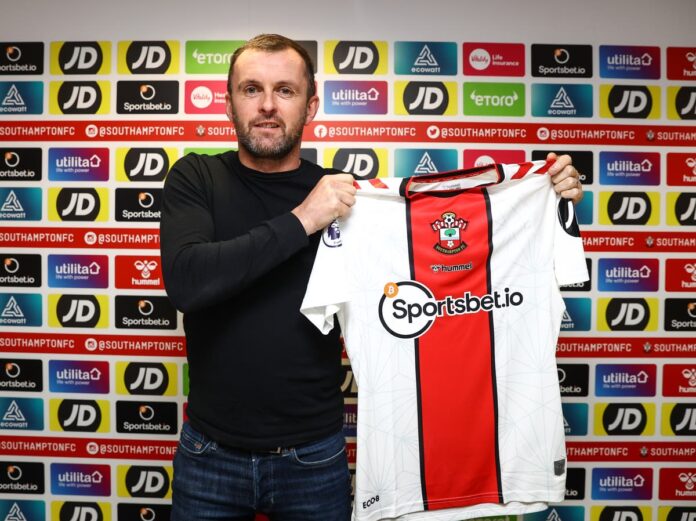Three bottom-half Premier League clubs have appointed a new manager in November. Spotting the odd man out is scarcely hard. Unai Emery and Julen Lopetegui are both recent Europa League winners. In each case, a Spaniard’s last job was at a La Liga club who have often overachieved in recent years: Villarreal for the new Aston Villa manager, Sevilla for his Wolves counterpart. They have had still more prestigious posts, Emery at Paris Saint-Germain and Arsenal, Lopetegui with Real Madrid and Spain.Then there is Nathan Jones. The man Southampton chose is another Spanish speaker and may share some footballing principles with his more decorated peers. The similarities end there. In January 2016, when Lopetegui was sacked by Porto, Jones was appointed by Luton, who were 15th in League Two. Emery, meanwhile, was part way through a campaign that would bring him and Sevilla a third straight Europa League.Fast forward almost seven years and Jones has taken Luton to two promotions and the Championship play-offs and himself into a division that has the pulling power to lure elite managers into relegation battles. He can seem an appointment from another era for Southampton: Lawrie McMenemy’s previous managerial job before taking charge of Saints was at Grimsby, Alan Ball’s at Exeter, Dave Jones’ at Stockport, and, less auspiciously, the despised Ian Branfoot’s at Reading. But since promotion to the Premier League in 2012, Southampton had appointed six managers, five sourced from abroad, with only Mark Hughes boasting a Premier League pedigree, and he ranked among the least successful. More often, they had seemed to be looking for the next Mauricio Pochettino and their quest rarely took them into the Football League.Jones has flown in the face of most trends. Perhaps Southampton, whose recruitment model on the pitch is about identifying emerging talent, feel they have found the next Graham Potter, a leftfield thinker with a low-key playing career but the coaching prowess to prevail against some of the game’s established greats. Jones’ wretched spell at Stoke, where they only won six times in 38 matches, may offer a warning: his brilliance has been confined to his twin spells at Luton. Southampton fans of a certain vintage may sense an unwanted parallel with Paul Sturrock, who prospered at Plymouth but not in Hampshire.But for Southampton, Jones feels part of a grander gamble on the untried. Their economic strategy feels ever riskier in a league that gets stronger, their idea that they can buy and blood talented young players, sell them for sizeable profits while forever staying up. Their £70 million summer spending spree – an antidote to years of austerity – produced two potential gems, in Romeo Lavia and Armel Bella-Kotchap – who was called up by Germany for the World Cup. The previous two summers yielded the sporadically superb but erratic Mohammed Salisu and the currently injured Tino Livramento. Yet the value of each would be considerably smaller if Southampton are a Championship club.That focus on the future arguably blinded Southampton to the present. Ralph Hasenhuttl and Mikel Arteta have fielded the division’s youngest sides this season, but their presence near either ends of the table tells different stories. In Southampton’s case, it reflected the way Hasenhuttl exiled most of the senior players, except James Ward-Prowse. Meanwhile, buying young seemed to leave Southampton ill-prepared for now. Concentrating much of their resources on defensive-minded players has left them short of goalscorers.That Jones took a squad including Cameron Jerome to the Championship top six suggests he can work with much-maligned forwards but Southampton have tended to play two strikers and, if Wolves’ injured contingent are ever fit, have arguably the least gifted group of attackers. They have too few match-winners and, should they go down, the eventual verdict may be that Southampton never fully recovered from the sale of Danny Ings, with Armando Broja’s loan mitigating the damage for a year.Certainly their direction of travel is downward. Hasenhuttl dealt in spells of boom and bust but Southampton only won four of his last 26 games. It feels entirely in character with a strange side that one was against Chelsea, another against Arsenal: when it went right, it could go very right for the Austrian, and when it went wrong, his side could lose 9-0.It seemed as though they lost more than merely matches this season: their identity as ferocious gegenpressers appeared gone. Hasenhuttl laid a template in terms of a style of play until then but relations with players were frayed. Jones marked his arrival by talking of a need for a ‘buy-in from everyone,’ which he had at Luton, but not at Stoke. He spoke of restoring ‘a clear identity’ and his own fondness for working with young players. He shares Hasenhuttl’s capacity to improve them.He does not arrive burdened by self-doubt. Hasenhuttl was branded the ‘Alpine Klopp’ and Jones’ first game is against the actual one, as Southampton visit Liverpool. He welcomed comparisons with his counterpart. ‘There’s a lot of characteristics of Jurgen I have,’ he said, deeming them both innovative and driven.All of which Southampton may require. Given Luton’s budget, Jones ranks among the best managers, pound-for-pound in the Football League in the last seven years. Hasenhuttl punched above his weight, too, in the seasons of a low net spend. Despite his long, drawn-out demise, he is the only one of the previous four appointments Southampton got right. Now they have looked to Luton rather than Leipzig, to an ultra-modern manager with an old-fashioned CV. In the era after Sam Allardyce and Tony Pulis, the relegation firefighter can be a former Europa League winner. Jones has beaten the odds to get this far. Now he may have to do so again.
Nathan Jones defies odds to take charge of Saints caught between present and future
Sourceindependent.co.uk
RELATED ARTICLES


